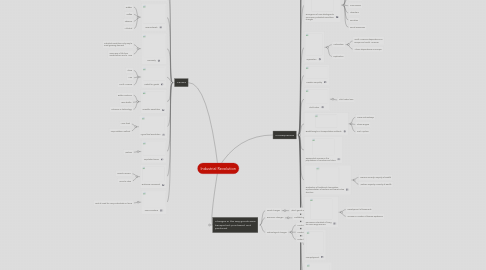
1. Causes
1.1. Low production in all sectors
1.1.1. Cottage industry
1.1.2. Farming by hand
1.2. Abundance of capital
1.3. Raw materials
1.3.1. Rubber
1.3.2. Coffee
1.3.3. Tobacco
1.3.4. Alchohol
1.4. Necessity
1.4.1. Industrial Revolution only way to meet growing demand
1.4.2. Same way of life from Greek/Roman era to 1700
1.5. Market for goods
1.5.1. Africa
1.5.2. Asia
1.5.3. South America
1.6. Scientific Revolution
1.6.1. Better medicine
1.6.2. Less deaths
1.6.3. Advances in technology
1.7. Agricultural Revolution
1.7.1. More food
1.7.2. Crop Rotation method
1.8. Population boom
1.8.1. Workers
1.9. Enclosure movement
1.9.1. Tenant Farmers
1.9.2. Move to cities
1.10. New Inventions
1.10.1. Lack of need for many individuals on farms
2. Changes in the way goods were transported, purchased, and produced
2.1. Social changes
2.1.1. Which goods were acceptable
2.2. Economic changes
2.2.1. Profitable goods
2.3. Technological changes
2.3.1. Production of more goods
2.3.2. Production of better goods
2.3.3. Faster transportation of goods
3. Consequences
3.1. Replacement of human labour with machines
3.1.1. Cotton Gin
3.1.2. Sewing Machine
3.1.3. Loom
3.1.4. Spinning Wheel
3.2. Rural to Urban Migration
3.2.1. Increase in city population
3.3. Increase in production for all sectors
3.3.1. Beef production in Uruguay
3.3.2. Silk industry in Japan
3.3.3. Sugar industry in Cuba
3.3.4. Textile industry in Britain
3.4. Improved standard of living for owners
3.4.1. Development of extravagant homes;
3.5. Economic and global, power and wealth to the industrialized nations
3.5.1. Japan
3.5.2. Britain
3.5.3. United States of America
3.5.4. France
3.6. Emergence of new ideologies to accompany Industrial Revolution changes
3.6.1. Capitalism
3.6.2. Conservatism
3.6.3. Romanticism
3.6.4. Communism
3.6.5. Liberalism
3.6.6. Socialism
3.6.7. Social Dariwinism
3.7. Imperialism
3.7.1. Colonialism
3.7.1.1. South American dependence on Europe and North American
3.7.1.2. African dependence on Europe
3.7.2. Exploration
3.8. Gender Inequality
3.9. Child Labor
3.9.1. Child Labor laws
3.10. Breakthroughs in transportation methods
3.10.1. Trains and Railways
3.10.2. Steam Engine
3.10.3. First Airplane
3.11. Exponential increase in the populations of countries and cities
3.12. Eradication of traditional class system; implementation of workers and owners class structure
3.12.1. Owners minority, majority of wealth
3.12.2. Workers majority, minority of wealth
3.13. Decrease in standard of living for some wage earners
3.13.1. Development of tenements
3.13.2. Increase in number of disease epidemics
3.14. Unemployment
3.15. Increase in quality and consistency of goods
3.15.1. Customers expect good quality goods
3.15.2. Competition between stores to provide better quality goods
3.16. Trade and Work Unions
3.16.1. Workers have a say in their career earnings and benefits
3.17. Public education systems
3.17.1. Better educated workers
3.18. Specialization of labor
3.18.1. Assembly Lines
3.19. Variety of goods
3.19.1. Competition between stores to provide more variety
3.20. Need for changed motivated individuals to try and join government
3.20.1. Reforms in the government
